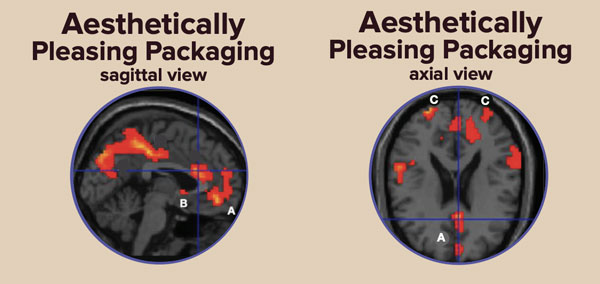Neurodesign identifies design aspects of physical or virtual objects and environments that our brains naturally find more appealing. It can be considered part of neuroaesthetics, the discipline that studies the neural mechanisms of our aesthetic evaluations.
Brain areas responsible for the perception of pleasure and beauty.
Translated into a design language, this means that a successful package has the power to activate particular brain areas responsible for decision making.
Ventromedial Prefrontal Cortex (vmPFC)
- activated in value-based choice processes
- performs the cognitive evaluation of morality
- activated when processing risk and fear
- involved in EMOTION regulation
- elicits reward
Dorsolateral Prefrontal Cortex (dlPFC)
- activated in deliberative cognitive processes in decision making
- involved in computation of actions and short- and long-terms goals
- modulates valuations (adding input)
- interrupts or overrides already computed evaluations
- activated during abstract REASONING
- activated when benefits of alternative choice are of interest (rational decisions)
Striatum
- inhibits control
- plans movements
- reacts to new or unexpected stimuli
Nucleus Accumbens
- cognitive processes of motivation and reward
- action reinforcement
Primary Visual Cortices
- recognize patterns
- process the form and location of stationary objects
STUDY 1
What happens to our brains when we choose between an organic and a conventional product? Using functional magnetic resonance imaging technology (fMRI), researchers were able to measure brain activity by detecting changes associated with blood flow when individuals were asked to choose between a conventional and an organic packaging. The resulting brain activation is graphically represented by color-coding the strength of activation across the brain.
RESULT
- For the ORGANIC product, the time response was higher and the dlPFC was activated: More attention focused on long-term goals (healthiness) was found to a ect behavioral choices. It seems that “rational” buying decisions that can be associated with activation in the dlPFC may override the emotional decision of the vmPFC.
- For the CONVENTIONAL product, the vmPFC was activated: Consumers’ choice was made on an emotional level. Self-control is crucial when it comes to primary triggers such as tempting (and unhealthy) food.
STUDY 2
What happens to our brains when we are presented with an aesthetically pleasing packaging design? In this neuromarketing study, an aesthetically pleasing packaging and a standardized popular packaging are compared. The fMRI revealed that the aesthetic packaging:
- Activates the vmPFC and the striatum, in particular
the nucleus accumbens - Activates the primary visual cortices
This implies:
The more aesthetic the packaging design, the more emotional processes will be engaged, resulting in increased reaction times. Consequently, consumers are more emotionally involved. In the case of beautiful packaging, there are major visual elaborations.

RESULT
Results say that di erentiation by aesthetic packaging design triggers reward and choice, despite someone’s lack of brand awareness and brand reputation. It also explains why sales of not very popular brands in bland packaging improve significantly when their packaging is enhanced by showing images of food with appetite appeal.
Sources: The role of ethics and product personality in the intention to purchase organic food products: a structural equation modeling approach (G. Guido, M.I. Prete, A.M. Peluso, R.C. Maloumby-Baka, C. Bu a) International Review of Economics, 2010, 57, 79–102. How personality makes a di erence (J.T. Plummer) Journal of Advertising Research, 2000, 40(6), 79–83.


